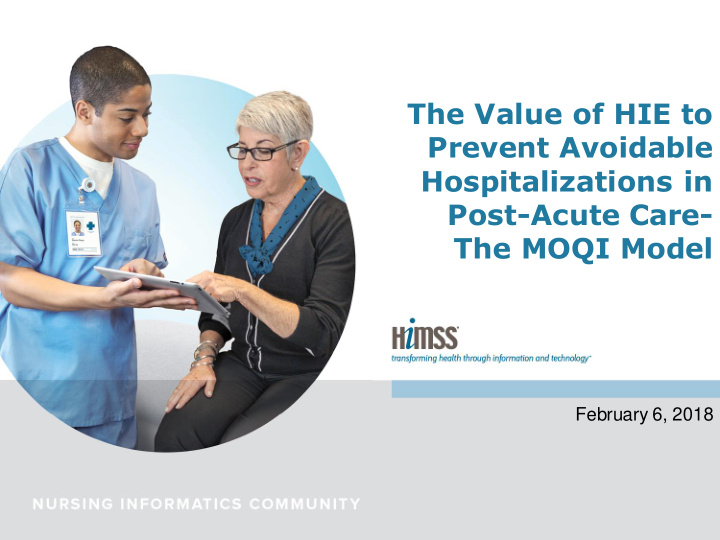



The Value of HIE to Prevent Avoidable Hospitalizations in Post-Acute Care- The MOQI Model February 6, 2018
Nursing Informatics Symposium Demonstrate Nursing Value through Health Information and Technology Monday, March 5 l 8:00am-4:30pm PT Learning Objectives: • Discuss how to reduce clinician burden with effective and efficient documentation • Explore how nurses can use predictive analytics to drive value • Outline innovative uses of telehealth and how it affects care coordination • Explore how to manage a cyberattack from an operational perspective • Share best practices and engage and network with colleagues
New at HIMSS18: Nursing Informatics Roundtable & Reception Nursing Impact on Quality Care Delivery Wednesday, March 7 l 4:00pm-5:00pm PT Reception to follow immediately 5:00pm-6:00pm PT Speakers: Nancy Beale , Vice President, Clinical Systems and Integration, NYU Langone Health Marie (Kim) Jordan , Senior Vice President, Patient Care Services & CNO, Lehigh Valley Health Network Michelle R. Troseth , Co-Founder, MissingLogic, LLC, President, National Academies of Practice
Speakers Gregory L. Alexander PhD, RN Professor, University of Missouri MOQI HIT Lead Sue Shumate BS, RN Primaris Health MOQI Health Information Coordinator
Objectives • Recognize critical stakeholders in an HIE network in a post-acute nursing home setting to prevent avoidable hospitalizations • Describe value propositions for stakeholders in an HIE network in post-acute care nursing homes • Identify processes of care crucial for achieving value propositions in an HIE network to prevent avoidable hospitalizations • State potential solutions to common barriers to HIE in post-acute care • Construct some strategies using health IT in care delivery to help attain value propositions and prevent avoidable hospitalizations
Presentation Outline • Introduction of Missouri Quality Improvement Model • Goals of MOQI Project • Implementation Process • Use Cases • Stakeholder Analysis • Strategies for Health IT adoption
MOQI Model
MOQI Project Goals • Reduce avoidable hospital transfers via four aspects of APRN Care Coordination 1. Condition management 2. Early illness detection 3. INTERACT 4. End-of-life/Advanced care planning • AND integrating health information technology into patient care processes
Health Information Technology Intervention • Promote the use of healthcare information technology (HIT) to improve the care of patients and communication among team members • Pursue integration and interoperability of all aspects of technology solutions • Train team members and nursing home staff regarding use of technology and workflow • Lead evaluation of software/components to be used in technological solutions • Systematic Feedback Reports to Users
MHC CareMail Implementation Process: Phase One • IT Readiness Assessment – HIT assessment; provide homes with scanners, computers and other IT equipment • Electronic Interfaces – 220 mailboxes • (DON, Nursing Staff, Social Services, APRN/Medical Directors) • System Administrator – Identify-proofed, key staff are identified and assigned mailboxes • Help Desk and Training
MHC CareMail Implementation Process: Phase Two • Work Flow Observations – Focused on behaviors associated with communication and documentation strategies • Identify NON-EMERGENT Use Cases for HIE Use – Scheduling appointments – Laboratory specimen drawing – Pharmacy orders and reconciliation – Social Work discharge planning – Admissions and pre-admissions – Pharmacy medication reconciliation Appl Clin Inform 2015; 6: 248 – 266 http://dx.doi.org/10.4338/ACI-2014-12-RA-0113
Non Emergent Use Case: Scheduling Appointments
Non Emergent Use Case Laboratory Specimen (Antibiotic Administration)
Non Emergent Use Case: Admissions and Pre-Admissions (Part 1)
Non Emergent Use Case: Admissions and Pre-Admissions (Part 2)
MHC CareMail Implementation Process: Phase Three • Maintenance and Ongoing Training – Semi-structure interviews: validated six use cases – Help desk reports – Usability survey – HIE e-mail use reports – Ongoing webinars – Building user network
Building Stakeholder Engagement St. Louis Regional LTPAC Technology Summit October 2017 Time Activity Topic 9:00am – Welcome Who and Why: Teams for today 9:15am 9:15am – Session 1 What are our value propositions? 10:30am 10:45am – Session 2 What processes of care help achieve our value? 12 noon 12:30pm – Session 3 How does health technology contribute? 1:45pm 2:00pm – What strategies can we apply to successfully achieve our Session 4 3:15pm value? 3:15pm – Let’s continue as teams for tomorrow Wrap-Up 3:30pm
Stakeholder Feedback on MOQI Outcomes: Change in Hospitalization Rates • 10 of 16 facilities had reductions in hospital admissions • Lots of variability – Simply noise – Don’t over compensate – Shift in outcome – Multiple causes? “Trying harder” is not sustainable – Shift in process – A new normal • Process Changes – APNs on site – Review all hospitalizations for root cause – Address causes Successfully Reducing Hospitalizations of Nursing Home Residents: Results of the Missouri Quality Initiative Marilyn J. Rantz, Lori Popejoy, Amy Vogelsmeier, Colleen Galambos, Greg Alexander, Marcia Flesner, Charles Crecelius, Bin Ge, Gregory Petroski http://dx.doi.org/10.1016/j.jamda.2017.05.027
Key Results with RTI- Comparison Group • 40% reduction in all-cause hospitalizations and • 57.7% potentially avoidable hospitalizations reduced (p=.001); • 54.1% all cause ED visits reduction and • 65.3% potentially avoidable ED visits reduced (p=.001). • 33.6% Medicare expenditures in all-cause reduced and • 45.2% in potentially avoidable hospitalizations (p= .001); • 50.2% Medicare expenditures in all-cause ED visits reduced and • 59.7% potentially avoidable ED visits reduced(p=.001). Ingber, MJ, Feng, Z, Khatutsky, G, et al. Evaluation of the initiative to reduce avoidable hospitalizations among nursing facility residents: Annual report project year 4, February, 2017. Available at: https://innovation.cms.gov/Files/reports/irahnfr-finalyrfourevalrpt.pdf. Accessed April 14, 2017. Centers for Medicare and Medicaid Services. Medicare Hospital Quality.
Stakeholder Engagement
Recommend
More recommend